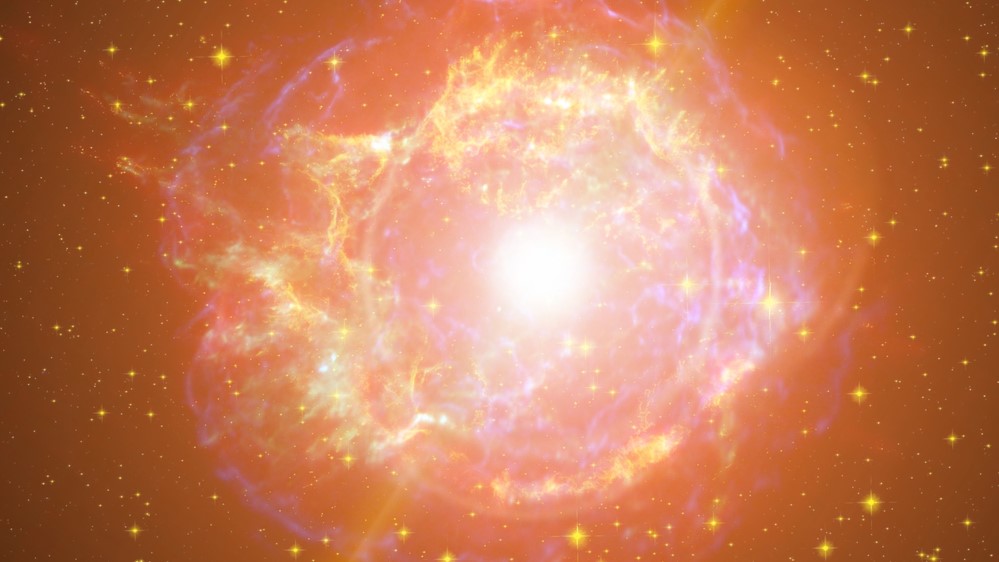Earth is at the center of a 1,000-light-year-wide 'Swiss cheese' bubble carved out by supernovas
The cosmic void is surrounded by multiple star-forming regions created by the explosions.

Earth is slap bang in the middle of a 1,000 light-year-wide bubble with a dense surface birthing thousands of baby stars. Researchers have long wondered what created this "superbubble." Now, a new study suggests that at least 15 powerful star explosions inflated this cosmic bubble.
Astronomers in the 1970s first discovered the gigantic void, known as the Local Bubble, after realizing that no stars had formed inside the blob for around 14 million years. The only stars inside the bubble either existed before the bubble emerged or formed outside the void and are now passing through; the sun is one such trespasser. This setup had suggested that several supernovas were responsible for this void. Those stellar explosions, the researchers said, would have blasted the materials needed to make new stars, such as hydrogen gas, to the edge of a huge area in space, leaving behind the Local Bubble that's surrounded by a frenzy of star births.
In the new study, published online Jan. 12 in the journal Nature, researchers accurately mapped the star-forming regions surrounding the Local Bubble and, in doing so, calculated how fast the superbubble is expanding. This allowed the team to work out exactly how many supernovas were needed to carve out the gigantic cosmic void and better understand how star-forming regions are created across the Milky Way.
Related: Cosmic record holders: The 12 biggest objects in the universe
"By tracing back the positions and motions of nearby young stars over the past millennia, we have reconstructed the history of our galactic neighborhood," lead researcher Catherine Zucker, a NASA Hubble fellow at the Space Telescope Science Institute in Maryland, told Live Science.
Expanding bubble
The Local Bubble is not a uniform sphere, because it was not formed by a single explosion. Instead, it is more like a lumpy blob created by multiple supernovas.
"Powerful supernova explosions triggered an expanding shock wave, sweeping up interstellar clouds of gas and dust into a dense shell that now forms the surface of the Local Bubble," Zucker said. The shock wave continues to push the surface outward, causing the bubble to expand.
Sign up for the Live Science daily newsletter now
Get the world’s most fascinating discoveries delivered straight to your inbox.
The researchers used data obtained by the European Space Agency's Gaia space observatory to create a 3D map of the Local Bubble's surface and to calculate the trajectory of the seven main star-forming regions that make up the "skin" of the bubble. The observations also allowed the researchers to work out how fast the cosmic void is expanding, which is currently around 4 miles per second (6.4 kilometers per second), according to a statement by researchers.
"We were able to figure out how much momentum is currently in the Local Bubble's expanding surface and compare it to how much momentum must have been injected by the supernovae to power its expansion," Zucker said. "We figured out that 15 supernovae were required to power the expansion given the shell's current momentum," which matches previous estimates made by similar studies. These supernovas likely originated from two separate star clusters over a period of millions of years, Zucker added.

"Swiss cheese" bubbles
The findings help to further our understanding of how star-forming regions are created.
"Astronomers have theorized for many decades that supernovae can sweep up gas into dense clouds that ultimately form new stars," Zucker said, "but our work provides the strongest observational evidence to date in support of this theory."
The Earth is currently located right at the heart of the Local Bubble, but that's not what makes this location special, Zucker said. "It is by chance that the sun is centered inside the bubble," she added; The sun was about 1,000 light-years away when the bubble first started forming and entered it only 5 million years ago.
According to the Copernican principle, which states that humans are not privileged observers of the universe and that Earth has no "special" location in the galaxy, our planet's position inside the Local Bubble suggests that superbubbles are likely very common throughout the Milky Way, Zucker said.
"We think that these bubbles are interacting with each other, with star-forming regions being at bubble intersections," Zucker said.
The Milky Way, therefore, "resembles very holey Swiss cheese, where holes in the cheese are blasted out by supernovae, and new stars can form in the cheese around the holes created by dying stars," co-author Alyssa Goodman, an astronomer at Harvard University, explained in the statement.
Passing through
The solar system won't always be stuck inside this bubble, the team found. "The sun should exit the bubble in about 8 million years," Zucker said. "But at that point, the bubble may no longer exist."
The Local Bubble's expansion is believed to be slowing down and will eventually disappear after reaching its max size, Zucker said.
"The Local Bubble is at the later stages of its life and will not continue to expand forever, and has actually plateaued in terms of its expansion speed," Zucker said. "Eventually, the Local Bubble will slow down enough that it merges with the general ambient gas of its surrounding environment."
Originally published on Live Science.

Harry is a U.K.-based senior staff writer at Live Science. He studied marine biology at the University of Exeter before training to become a journalist. He covers a wide range of topics including space exploration, planetary science, space weather, climate change, animal behavior and paleontology. His recent work on the solar maximum won "best space submission" at the 2024 Aerospace Media Awards and was shortlisted in the "top scoop" category at the NCTJ Awards for Excellence in 2023. He also writes Live Science's weekly Earth from space series.









